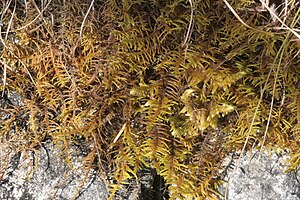Abietinella abietina
| Abietinella abietina | ||||||||||||
|---|---|---|---|---|---|---|---|---|---|---|---|---|

Abietinella abietina |
||||||||||||
| Systematics | ||||||||||||
|
||||||||||||
| Scientific name | ||||||||||||
| Abietinella abietina | ||||||||||||
| ( Hedw. ) Meat. |
Abietinella abietina is a species of deciduous moss in the Thuidiaceae family . It is also under the synonym Thuidium abietinum (Hedw.) Schimp. known. German-language names are Echtes Tannen-Thujamoos and Echtes Tannenmoos, also known as Tannenmoos or Tännchenmoos. The Bryological-Lichenological Working Group for Central Europe haschosenthis species as Moss of the Year 2011 .
features
Abietinella abietina grows in often extensive, loose lawns. These are dull, yellow-green to brown-green, in shady areas also fresh green. The strong, little branched and mostly ascending stems are simply pinnate. Stem leaves and branch leaves are designed differently. The larger, 1.2 to 3.7 millimeters long, loosely fitting stem leaves are broadly ovate with an extended and often bent tip, have four longitudinal folds and a simple rib that ends in front of the leaf tip. The leaf margins are flat or rolled up, with entire margins to crenulated and occasionally slightly serrated at the tip. Branch leaves are significantly smaller. Trunks and branches are also covered with numerous lanceolate or thread-like, simple or branched and papillary paraphyllia .
The leaf cells are about 7 to 11 µm in size, round, rhombic or oval, often bulky, thick-walled and have a high papilla on each side. The cells at the base of the leaf are elongated and spotted.
The species is dioecious . Sporogons are formed only extremely rarely, they have a reddish, 1.5 to 3 cm long seta and an almost upright, cylindrical and slightly curved capsule with a conical to very short beaked lid and cap-shaped hood.
Varieties
There are two varieties of Abietinella abietina , which differ in their morphological differences and somewhat different location requirements:
- Abietinella abietina var. Abietinum has hollow, broadly ovate and briefly pointed, 1 millimeter long branch leaves with rolled leaf margins. It grows in light to sunny, predominantly weakly basic substrate on dry locations, which are characterized by strong warming and occasional dry phases. Typical accompanying mosses are Rhytidium rugosum , Homalothecium lutescens , Entodon concinnus and Hypnum cupressiforme var. Lacunosum .
- Abietinella abietina var. Hystricosum has long, pointed, 1.5 millimeter long branch leaves with mostly flat leaf margins. The plants of this variety are usually stronger, more densely branched, dark green and often have one-sided branch tips. It grows preferentially in areas with a balanced, oceanic climate, requires more moisture and avoids locations that are too warm.
Both varieties are connected by an intermediate form, known as Abietinella abietina var. Abietinum fo. intermedium is described. A clear separation is therefore not always possible.
distribution
Abietinella abietina occurs in large parts of the northern hemisphere.
Abietinella abietina var. Abietinum is widespread in Central Europe from the plains - though mostly rarely here - up to the alpine altitudes. Var. hystricosum has its main distribution in the chalk area of southern England, in the rest of Europe there are only relic occurrences.
literature
- Ruprecht Düll , Barbara Düll-Wunder: Determine mosses easily and reliably. An illustrated excursion guide to the types of Germany and neighboring countries. Quelle & Meyer, Wiebelsheim 2008, ISBN 978-3-494-01427-2 .
- Jan-Peter Frahm , Wolfgang Frey : Moosflora (= UTB . 1250). 4th, revised and expanded edition. Ulmer, Stuttgart 2004, ISBN 3-8252-1250-5 .
- Martin Nebel, Georg Philippi (ed.): The mosses of Baden-Württemberg. Volume 2: Special part, (Bryophytina II, Schistostegales to Hypnobryales). Ulmer, Stuttgart 2001, ISBN 3-8001-3530-2 .
Individual proof
- ↑ Oliver Dürhammer: Abietinella abietina (Hedw.) M. Fleisch. var. abietina. In: Moose Germany . Retrieved March 14, 2014 .

